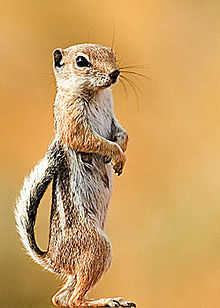Sciuromorpha
| Sciuromorpha Temporal range:
Late Paleocene to Recent | |
|---|---|

| |
Ammospermophilus leucurus
| |
| Scientific classification | |
| Domain: | Eukaryota |
| Kingdom: | Animalia |
| Phylum: | Chordata |
| Class: | Mammalia |
| Order: | Rodentia |
| Suborder: | Sciuromorpha Brandt, 1855 |
| Families | |
|
†Allomyidae Sciuridae †Reithroparamyidae Gliridae
| |
Sciuromorpha (Sciuridae (the squirrel family) as well as the mountain beaver species.
Traditionally, the term has been defined on the basis of the shape of the
Geomyidae are truly sciuromorphous. Some authorities would exclude the Geomyidae and Heteromyidae from that list due to the attachment of the medial masseter directly behind the zygomatic arch
.

Carleton and Musser (2005) redefined the rodent suborders on
infraorder (Sciurida) or superfamily (Sciuroidea). It has long been suggested that dormice (Gliridae) are not particularly related to the Myomorpha, and their zygomasseteric structure has been termed "pseudomyomorphy". The connection between squirrels and dormice has been almost exclusively suggested through genetic studies, and to a lesser degree via the fossil
rodent Reithroparamys.
Current families
The suborder Sciuromorpha contains 307 living species in 61 genera and three families. At least three extinct families are also recognised.
- † Allomyidae
- Aplodontiidae – mountain beaver
- † Mylagaulidae
- Sciuridae– squirrels, chipmunks, marmots, flying squirrels, etc.
- † Reithroparamyidae
- Gliridae– dormice
Historical families
- Castoridae – beavers
- Geomyidae– pocket gophers
- Heteromyidae – pocket mice, kangaroo rats, and kangaroo mice
- Pedetidae – springhares
- Anomaluridae – anomalures
References
- Carleton, M. D. and G. G. Musser (2005). "Order Rodentia". pp. 745–752 in Mammal Species of the World A Taxonomic and Geographic Reference (D. E. Wilson and D. M. Reeder eds.). Baltimore: Johns Hopkins University Press.
External links
 Data related to Sciuromorpha at Wikispecies
Data related to Sciuromorpha at Wikispecies
